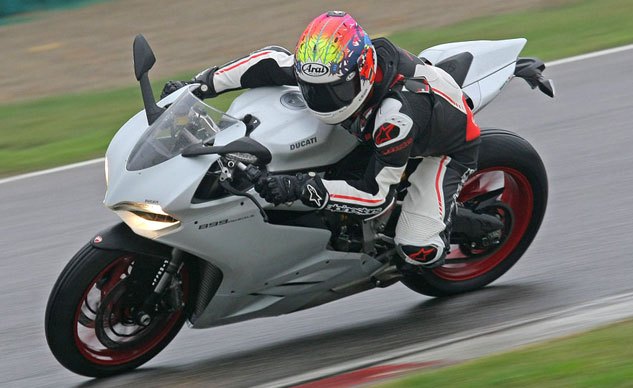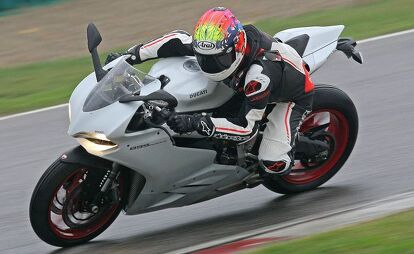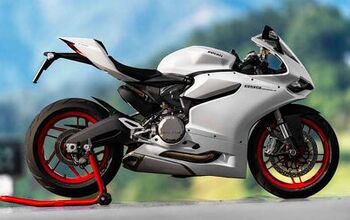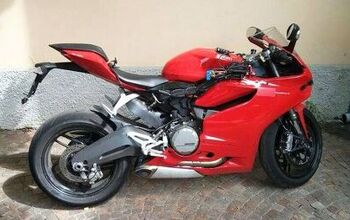2014 Ducati 899 Panigale Review – First Ride

We flog the baby Panigale in the wet at Imola
There’s no doubt about it, the Ducati 1199 Panigale is one sexy motorcycle. Its elegant curves and sharp lines make it a bike worth lusting after. If you’re up for it, the 1199cc Superquadro engine will exhilarate the soul unlike anything else we’ve ever ridden, just look how much we gush about the thing in our track and street portions of our 2013 Exotic Literbike Shootout.
2014 Ducati 899 Panigale
| Engine | 17/20 |
| Suspension/Handling | 12/15 |
| Transmission/Clutch | 9/10 |
| Brakes | 9/10 |
| Instruments/Controls | 4/5 |
| Ergonomics/Comfort | 8/10 |
| Appearance/Quality | 10/10 |
| Desirability | 9/10 |
| Value | 8/10 |
| Overall Score | 86/100 |
Ducati realizes this kind of enthusiasm is shared by many, but also understand the 1199 is out of reach for some. Meanwhile, the 848 EVO was becoming long in the tooth, and with the introduction of the 1199, it was clear a new era in superbikes from Ducati was upon us.
The 1199 was the springboard that launched rumors about the 848’s replacement. But there were still questions surrounding the new bike’s displacement, features, and whether it would retain the same monocoque chassis as the big bike. Then spy photos emerged of an 898cc version of the Panigale, and many of our queries were answered when we reported on it back in August.
Now Ducati has officially taken the wraps off its latest addition to the superbike family, the 2014 899 Panigale. Maintaining the lineage of smaller displacement versions of the company’s flagship superbikes (e.g. 748, 749, and 848), the 899 Panigale keeps the line going, throwing the definition of middleweight sportbikes out the window. Only a decade ago the 999 was the company’s flagship superbike. Seems a bit odd now that a machine only 100cc less is considered a middleweight.
It’s All Semantics
Strangely, Ducati is billing the 899 as a street-oriented sportbike first. One you can ride to the racetrack, flog for an entire trackday, then ride home. The 899 earns this distinction because its bars are 10mm higher and 30mm closer to the rider than the outgoing 848. However, the 1199 Panigale shares these same dimensions and it’s not the Ducati I think of when covering long distances is the goal. To be fair, the 899 does receive more padding in the saddle while retaining the same 32.5-inch seat height as the 1199, so there is a slight nod to comfort when comparing the two Panigales.
Beyond being a more approachable, friendlier Panigale, the 899 is aiming for a different market than its bigger brother. These people are young, working-class professionals who live an active lifestyle, may have a passing interest in racing, but most of all want to enter the world of premium sportbikes. Ducati noted that in the U.S. specifically, military members were a large and unexpected demographic. With its $14,995 price tag, the 899 Panigale delivers a cost slightly above its 600cc “rivals” (can you really call the them that now?), and at $15,295 for the Arctic White seen in these photos, it’s four dollars less expensive than a 2014 Kawasaki Ninja ZX-10R ABS, the most expensive Japanese literbike currently on the market.
To reach this price point, some concessions had to be made. You won’t find exotic materials here, as evidenced by the steel trellis subframe hanging off the back instead of the aluminum piece on the big brother, but the essence of the Panigale still remains. Clearly, engine size is the most obvious difference between the two.
The 898cc Superquadro starts with the 1199 block, then receives new cylinder sleeves to bring the bore down to 100mm. It’s coupled with a new crankshaft, reducing stroke to 57.2mm. For comparison, bore and stroke on the 1199 measures 112mm x 60.8mm, and 94.0mm x 61.2mm for the 848. Pistons are forged aluminum. Transmission is unchanged from the 1199, but final drive gearing has gone from 15/39 on the 848 EVO to 15/44 on the 899. From there aluminum, not magnesium, is used for the clutch, valve and sump covers.
The smaller engine size required the need for new cylinder heads. Compression ratio is set at 12.5:1, while steel valves — 41.8mm intake, 34.0mm exhaust — all receive a diamond-like carbon coating for minimal friction and fatigue to the material. Oval throttle bodies equivalent to 62mm diameter are electronically controlled and feed air past a single fuel injector to the cylinder for combustion.
Like all Ducati V-Twins, the vee angle is 90 degrees. The cylinders are rotated backwards on the crank axis, positioning the front cylinder 21 degrees from horizontal. This allows it to be placed as far forward as possible for optimal weight distribution, but also positions the cylinder heads appropriately to attach the rest of the motorcycle since the engine serves as the main stressed member of the monocoque chassis.
All told, Ducati says the 899 makes 148 hp to the crank at 10,750 rpm. That’s eight horses more than the 848, 250 revs higher on the tach. Torque is rated at 73.1 ft.-lbs. at 9000 rpm, versus 70.2 ft.-lbs. at 9750 rpm.
What sets the 899 Panigale apart from its rivals in the class is its standard electronics suite including ABS, Ducati Traction Control (DTC), Ducati Quick Shifter (DQS), Engine Brake Control (EBC), and three different ride modes: Race, Sport, and Wet. All are adjustable with a push of a button with the left thumb. The exception being DQS, which is always on.
Bits And Pieces
On the chassis side, a cast aluminum, traditional, not single-sided, swingarm is the biggest giveaway you’re looking at a 899 and not the bigger model. Because of the reduction in power, Ducati says its engineers were able to get away with making the 899 swingarm shorter, sacrificing stability in the name of agility. Overall wheelbase is down to 56.1 inches, compared to 56.8 inches and 56.3 inches on the 1199 Panigale and 848 Evo, respectively.
Suspension components include Showa Big Piston Fork and a Sachs shock. Though less exotic than typical Ducati fare, both are fully adjustable and help keep costs down. Brembo provides the stopping power with four piston M4.32 monobloc calipers instead of the M50 on the 1199, and 320mm discs. As mentioned before, ABS is standard and adjustable to three different levels (four including off). Ducati worked in conjunction with Pirelli, fitting the 899 with Diablo Rosso Corsa rubber in 120/70-17 front and 180/60-17 rear profiles, the same sizes used in World Supersport competition.
These minor tweaks to the 899 have resulted in geometry figures slightly different than the 1199 and 848. Rake is set at 24 degrees, which is half a degree sharper than both the other bikes. With the shorter swingarm and wheelbase as mentioned before, in theory the 899 should be quite the agile machine. According to Ducati, curb weight is 425.5lbs., five pounds less than the 848 EVO.
Rain, Rain — Go Away!
The world’s press gathered at the Autodromo Internazionale Enzo E Dino Ferrari, the track better known as Imola, to romp the new 899 Panigale around this legendary circuit. However, the weather gods had other ideas, showering us with a light rain in the morning that worsened as the day went on. Luckily, Pirelli fitted every bike with its WSBK-spec rain tires in the same size as stock, allowing the day to be salvaged somewhat, but I only got three 15-minute sessions aboard the bike before the heavens opened up and ended our day prematurely.
Forty-five minutes around an unfamiliar and wet track is definitely not enough time, but still a few impressions stood out. Despite the marketing materials, the 899 Panigale is not a motorcycle I’d want to do any long-distance riding on. Sure the bars are 10mm taller than the outgoing 848 EVO and its pegs give the same impressive leg room we liked in the 1199, but a touring bike that does not make. The 899, and 1199 before it, delete all ambiguity as to the riding position and environment it thrives in. Corners are where it shines, and the straights leading up to them are opportunities to get the most out of the engine.
The first track session was done, appropriately enough, in Wet mode. Here, power is restricted to 100 hp, power delivery is very gentle, traction control is set to maximum (out of eight settings), ABS is set to level three, the most intrusive setting, and EBC is set to one, allowing the most engine braking. This was a great setting to learn a new track, especially one this legendary, in the rain, as safety is the paramount priority over lap times. Power delivery is indeed gentle and I often found myself twisting the throttle to the stop exiting corners. Had we been on standard road tires, I’m sure I wouldn’t have been as judicious with the gas.
That said, the racing tires and soft power delivery meant I hardly noticed the TC indicator light on the TFT gauge cluster lighting up. However, even at my slow pace on an unfamiliar track, the ABS would intervene much too early and abruptly. Moderate braking power would be enough to trigger the ABS. The subsequent pulsing at the lever made it hard to know whether I’d scrubbed enough speed to make the corner or not. However, it’s important to note again the grip provided by the rain tires was exceptional. Had we been running the standard Diablo Rosso Corsa tires, the early ABS activation could be justified.
For the next session, ride mode was changed to Sport, which delivers full power with a soft initial output. DTC is lowered to five, ABS drops to level two and EBC remains at one. For this particular session, EBC was changed to level two for comparison’s sake. The extra power was a welcome addition, though the constant illumination of the TC light meant the on-board computers were saving my tail from a massive highside out of every corner. So it was next to impossible to really feel the true power available under these conditions, but it was also impressive to only realize the TC was activating based on the indicator light flashing in my face. ABS was still too intrusive for my tastes, only slightly less scary as level three. The strangest feeling came from the EBC, as there was an instance under braking in level two where the rear wheel skipped momentarily. Then again, it could have also been an anomaly as it didn’t happen again.
What would end up being my last session I spent in Race mode, which gives full power delivery. DTC was bumped up to level five instead of level two and both ABS and EBC were at their standard settings of one. Changing the levels is done with the left thumb, but the process requires a complex series of button presses that would be next to impossible to accomplish at speed. With these modified settings, I was finally getting comfortable pushing my pace in the wet conditions.
Power delivery felt obviously stronger than the other two sessions, but I expected more punch in Race mode. But it was wet, and the conditions were anything from ideal, so a true gauge of the 899’s power this definitely is not. Considering the constant illumination of the DTC light accelerating out of nearly every corner, what’s impressive is the refinement of the DTC software, as its intervention has hardly become intrusive to the ride experience. Especially compared to the first iteration of DTC I tried in 2008 on the 1098R.
With ABS at its lowest setting and EBC at its highest, the 899 finally felt comfortable under braking, as the ABS is calibrated for racetrack settings with no provisions for stopping the rear wheel from lifting, meaning it didn’t intrude at all during my session. The EBC also let the V-Twin engine freewheel naturally — a feeling I’m used to — without upsetting the chassis any.
These Brembos may not have been the phenomenal M50s on the big bike, but the strong power and superb feel at the lever from these brakes was highlighted further under wet conditions. However, it’s hard to comment on the braking and handling abilities of the 899 considering every bike was outfitted with racing-spec rain tires with a much different profile and extremely better wet grip levels than the standard Diablo Rosso Corsa. Couple that with the fact my highest priority was keeping the bike upright in these conditions, and I’ll have to save judgment until we can get one in our hands for a thorough shakedown in the dry. What I can gripe about are the incredibly slippery pegs in wet conditions, making them annoying at best, but also potentially dangerous.
For now, what I can attest to after 45 minutes aboard the 899 Panigale at a wet, but still exhilarating, Imola circuit is the little Panigale offers a lot of performance and technology for the price. The jury is still out on its outright performance and street manners in the dry, but rest assured we’re working on securing a test bike as quickly as possible to bring these impressions to you.
+ Highs
- Drop dead sexy
- Impressive electronics package
- Decent legroom
– Sighs
- Rain
- Slippery pegs
- Oh, did I mention it was raining?

Troy's been riding motorcycles and writing about them since 2006, getting his start at Rider Magazine. From there, he moved to Sport Rider Magazine before finally landing at Motorcycle.com in 2011. A lifelong gearhead who didn't fully immerse himself in motorcycles until his teenage years, Troy's interests have always been in technology, performance, and going fast. Naturally, racing was the perfect avenue to combine all three. Troy has been racing nearly as long as he's been riding and has competed at the AMA national level. He's also won multiple club races throughout the country, culminating in a Utah Sport Bike Association championship in 2011. He has been invited as a guest instructor for the Yamaha Champions Riding School, and when he's not out riding, he's either wrenching on bikes or watching MotoGP.
More by Troy Siahaan















































Comments
Join the conversation
The new baby Panigale looks like the perfect track day toy of my dreams. My reality is more along the lines of a used SV650, with suspension mods. Reality is a lot more manageable should the front end go away while leaned over at 70 mph. One can dream though :)
I wouldn't track this bike or any other that I paid more than $5000 for because it would do absolutely nothing for me. I apply the same line of thought when I think of a sport that will never be a part of my professional life. The parallel I'm drawing here is the 100m sprint. I'm no Usain Bolt and it wouldn't make much of a difference for me whether I bought the same track shoes as the fastest sprinter on earth wears. Nor will those shoes really add to my experience in terms of fun factor. Sure I'll be faster on a 1199 or S1000RR than my 600 (or will I?), but at what risk? If speed equates to fun, how much fun does one have driving down the freeway in a car doing 75 VS riding around the neighborhood in a 125cc scooter? Before this comment gets convoluted and out of control I will close by saying, I'm no where near good enough or deserving enough to track a beautiful bike like this 899. So for me, I'll stick to my old 600. But if I want bragging rights on the road during a nice quick Sunday dash around town, I'll go ahead and ride off into the sunset on a 1199.